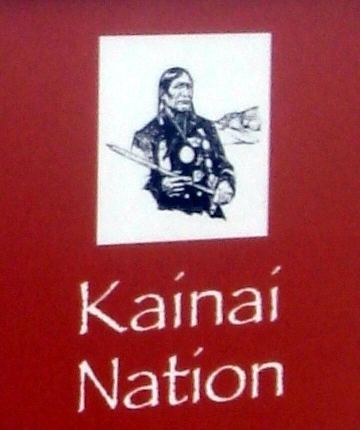 | ||
The Kainai Nation (or Káínawa, or Blood Tribe) is a First Nation band government in southern Alberta, Canada, with a population of 1000 members in 2005,
Contents
Akáínaa translates directly to "Many Chief" (from aká - "many" and nínaa - "chief") while Káína translates directly to "Many Chief people." The enemy Plains Cree called the Kainai Miko-Ew - "stained with blood", i.e. "the bloodthirsty, cruel", therefore, the common English name for the tribe is the "Blood tribe."
The Kainai speak a language of the Algonquian linguistic group; their dialect is closely related to those of the Siksika and Peigan. They are one of three nations comprising the Blackfoot Confederacy.
At the time treaties such as Treaty 7 were signed, the Kainai were situated on the Oldman, Belly, and St. Mary rivers west of Lethbridge, Alberta. The Kainai reserve Blood 148 is currently the largest in Canada with 3,852 inhabitants on 1,414.03 km² and is located approximately 200 kilometres south of Calgary. As of December 2013, the Kainai Nation had a total registered population of 11,791 people.
Band council
The Kainai Nation is governed by an elected council of twelve to fifteen, with one chief. The term of office is four years. Historical chiefs of the Kainai are below:
Blood Tribe Councillors (2016–present)
- Dorothy First Rider
- Floyd Big Head
- Kyla Crow
- Lance Tailfeathers
- Martin Heavy Head
- Franklyn White Quills
- Joanne Lemieux (Blood)
- Robyn Little Bear
- Kirby Many Fingers
- Hank Shade
- Tim Tailfeathers
- Marcel Weasel Head
Police force
In pre-treaty times, the iikunuhkahtsi were a society responsible for the punishment of misdeeds. The Blood reserve is currently policed by the Blood Tribe Police, with 31 officers in 2015.
Notable people
Media
In 1960, the Kainai and their sacred Sun Dance were featured in the National Film Board of Canada documentary Circle of the Sun. Tribal leaders had been concerned that the Sun Dance might be dying out, and had permitted filming as a visual record.
On National Aboriginal Day in 2011, the NFB released the Pete Standing Alone trilogy, which includes Circle of the Sun, Standing Alone and a 2010 film, Round Up, documenting 50 years of the Kainai Nation as well as the life of elder Pete Standing Alone.
Historical Newspapers
Communities
The Kainai nation communities include:
